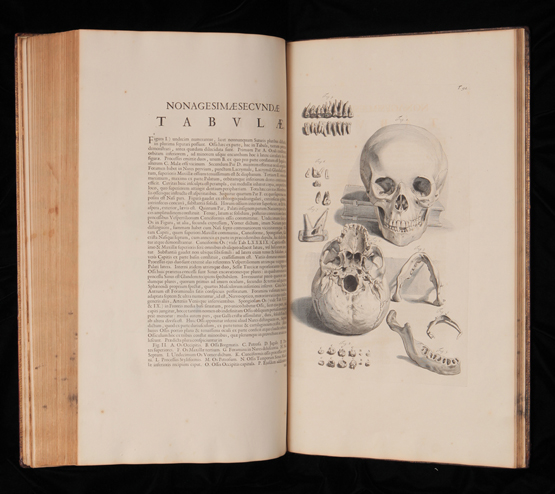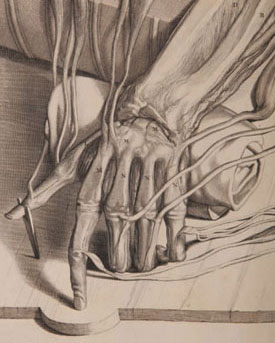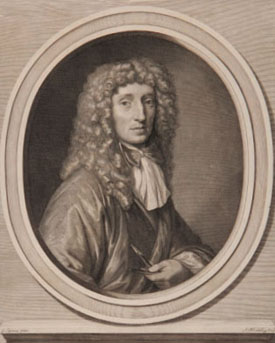The Millionth Volume: Library's Historic Acquisition Mixes Art & Science
For a librarian, it’s likely to be a once-in-a-career event—choosing the millionth volume. Lists of candidates must be compiled, symbolic attributes must be considered. The millionth book must somehow embody the character and the mission of the institution. The millionth book must be … well, weighty.
At nearly 20 pounds, Vassar’s millionth volume, Anatomia humani corporis by Govard Bidloo, is a magnificent choice because of its multidisciplinary significance. “At the time of its publication in 1685,” says Ron Patkus, director of the Vassar Archives and Special Collections, “the Anatomia represented the most significant innovation in anatomical illustration in over a century.” Bound in Moroccan leather, the large folio comprises 105 engraved plates of anatomical drawings by Gerard de Lairesse. With a few exceptions, these are not idealized or diagrammatic representations of the human body, as was typical in early atlases of human anatomy. They are naturalistic drawings of actual cadavers, remarkable for their sensuous portrayal of their subjects—a young woman with cascading hair and full lips who seems to be merely asleep, her abdomen flayed open and held back with surgical pins to reveal her gastrointestinal organs.

“I love this book,” says Patkus, “but what’s really exciting to me is how it will be used. We didn’t purchase this book to keep it locked up. Several professors have already scheduled classes around it.” Susan Kuretsky ’63, Professor of Art on the Sarah G. Blanding Chair, is the faculty member who first put the book on Patkus’s radar, but it’s also fascinating from the point of view of scientists, historians, and even legal theorists. Copyright laws as we know them didn’t exist at the time, and when sales of Bidloo’s Anatomia began to flag, the publisher sold the plates to an English surgeon, William Cowper, who rewrote the text in English, replaced Bidloo’s name on the title page with his own, and published the book under the title The anatomy of humane bodies in 1698. An international squabble ensued, but Bidloo’s claim was never vindicated.
The stories of the two Dutchmen who made the book are also intriguing. Bidloo, the author, was a successful playwright as well as a medical doctor who was appointed professor of anatomy at The Hague in 1688 and royal physician to William III of England in 1701. A year later, according to K. B. Roberts (The Fabric of the Body, 1992), Bidloo “attended William during his last illness, prescribing, for the infected dropsy that affected the King’s feet and legs, a powder of crabs’ eyes, flour, and cumin seed rubbed on with flannel, vapour baths, and a diet of strong beer.” William reportedly died in his arms. Bidloo returned to academia in the Netherlands, where he died in 1713. “There is little doubt,” writes Roberts, “that Bidloo was an irascible man who argued with his medical colleagues both face to face and in print. No one seems to have been willing to give an oration at Bidloo’s funeral.”


Gerard de Lairesse, the illustrator, was a painter and an art theorist who suffered from congenital syphilis that ultimately left him blind. He started out in Utrecht where, according to Roberts, “he was said to have been dissolute and poor.” He fled to Amsterdam after a duel and eventually became a highly successful painter. “Anecdotes of Lairesse abound,” writes Roberts. “[B]efore beginning a painting he would, like Sherlock Holmes, play the violin to assist contemplation; for a wager, he painted a large canvas of Apollo and the Muses in less than one day....”
The book took six years to make, and it was not a best seller, even by 17th-century standards. The publisher probably sold the plates to try to recoup some of his losses. But today, the 100 copies still in existence are the prized treasures of the world’s great academic libraries, among them Oxford, Cambridge, Harvard, Yale—and Vassar.
Bidloo’s extraordinary volume was purchased as a gift to Vassar by the Class of 1972.
